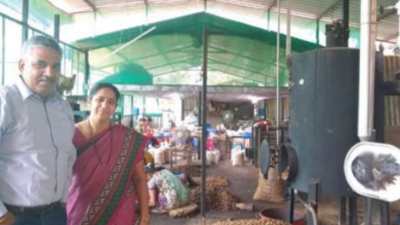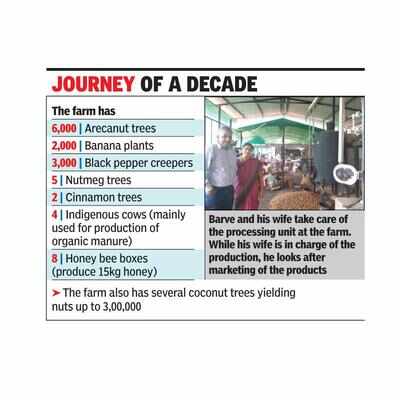PANAJI: A horticulture cum livestock cum apiculture-based integrated farming system, that was developed at the farm of Valpoi-based farmer Vinod Barve about a decade ago on an experimental basis, fetches him a net income of Rs 40.7 lakh per annum today. With nothing to lose, the farmer allowed the Old Goa-based ICAR-CCARI to develop the model at his farm that now grows fruit and spice crops, has indigenous cows and bee boxes generating him milk, honey and organic manure.
“The ICAR-CCARI held a series of seminars enlightening farmers about this project. Inspired by the idea, I decided to approach them to adopt the system. It was a slow process of converting the farm into an integrated system. Once it was fully functional, I was able to carry it out successfully,” Barve said.
With Barve primarily being a banana farmer, he was able to boost the horticulture crop’s cultivation following the adoption of this model. However with the Covid-19 pandemic hitting the sale of bananas, he expanded the model to include a banana chips’ processing unit.
“I was the first person in Goa to set up a banana processing unit, as a result. Currently, the chips are only processed in Kerala. Selling the chips generated better income compared to the fruit,” Barve said.
Owing to the success of this processing unit, he very recently also took on the processing of jackfruit chips. While his wife handles the production, Barve managed the marketing aspect by selling his products in Panaji and Margao.
Apiculture is not able to bring in a big profit. However, due to apiculture, the production of cashew and coconut crops in the farm have increased owing to pollination. In dairy farming, milk may be the main product, but the cow dung acts as a byproduct.
“This is used to generate gobar gas as a result of which the major earnings in dairy farming are through the dung and not the milk,” he said.
Moreover, the leaves of the arecanut crop are not discarded by the farmer. He uses them to prepare eco-friendly and biodegradable food plates and bowls that are sold to caterers.
“Running a successful model like this however requires a lot of patience and dedication. It was a slow process since it takes four to five years for the crops to produce yield. The first half of the decade therefore was hard work while the results have been generated in the following five years,” he said.
“The ICAR-CCARI held a series of seminars enlightening farmers about this project. Inspired by the idea, I decided to approach them to adopt the system. It was a slow process of converting the farm into an integrated system. Once it was fully functional, I was able to carry it out successfully,” Barve said.
With Barve primarily being a banana farmer, he was able to boost the horticulture crop’s cultivation following the adoption of this model. However with the Covid-19 pandemic hitting the sale of bananas, he expanded the model to include a banana chips’ processing unit.
“I was the first person in Goa to set up a banana processing unit, as a result. Currently, the chips are only processed in Kerala. Selling the chips generated better income compared to the fruit,” Barve said.
Owing to the success of this processing unit, he very recently also took on the processing of jackfruit chips. While his wife handles the production, Barve managed the marketing aspect by selling his products in Panaji and Margao.
Apiculture is not able to bring in a big profit. However, due to apiculture, the production of cashew and coconut crops in the farm have increased owing to pollination. In dairy farming, milk may be the main product, but the cow dung acts as a byproduct.
“This is used to generate gobar gas as a result of which the major earnings in dairy farming are through the dung and not the milk,” he said.
Moreover, the leaves of the arecanut crop are not discarded by the farmer. He uses them to prepare eco-friendly and biodegradable food plates and bowls that are sold to caterers.
“Running a successful model like this however requires a lot of patience and dedication. It was a slow process since it takes four to five years for the crops to produce yield. The first half of the decade therefore was hard work while the results have been generated in the following five years,” he said.
FOLLOW US ON SOCIAL MEDIA
FacebookTwitterInstagram
Looking for Something?

Start a Conversation
end of article
Visual Stories
Quick Links
Delhi Air PollutionDelhi TemperatureChennai WeatherBangalore TemperatureCovid vaccination centres in DelhiCoronavirus in DelhiRTPCR test in GurgaonHyderabad RainPollution level in BangaloreDelhi SmogDelhi TemperatureNoida AQIGurgaon AQI todayFire in MumbaiMumbai RainsCovid 19 RT PCR Test in NoidaDelhi AQI todaySrinagar encounter



